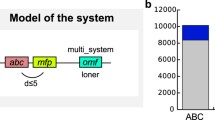Abstract
Protein secretion is an important aspect of bacterial interaction with the environment. The WXG100 secretion system is a poorly understood pathway for the secretion of members of the WXG100 protein family in Firmicutes and Actinobacteria, notably Mycobacteria. This pathway has also been termed the Type VII secretion system but there are semantic problems with this nomenclature. This Perspective reviews the phylum level distribution of WXG100 secretion systems and presents comparative genomic evidence that these systems are present in several Chloroflexi and in some members of the phyla Cyanobacteria, Lentisphaerae, Proteobacteria (notably Helicobacter pylori) and Verrucomicrobiae. These findings have implications for the nomenclature of the WXG100 secretion pathway.
Similar content being viewed by others
References
Abdallah AM, van Pittius NCG, DiGiuseppe Champion PA, Cox J, Luirink J, Vandenbroucke-Grauls CMJE, Appelmelk BJ, Bitter W (2007) Type VII secretion—mycobacteria show the way. Nat Rev Microbiol 5:883–891
Akpe San Roman S, Facey PD, Fernandez-Martinez L, Rodriguez C, Vallin C, Del Sol R, Dyson P (2010) A heterodimer of EsxA and EsxB is involved in sporulation and is secreted by a type VII secretion system in Streptomyces coelicolor. Microbiology 156:1719–1729
Bitter W, Houben ENG, Bottai D, Brodin P, Brown EJ, Cox JS, Derbyshire K, Fortune SM, Gao L-Y, Liu J, van Pittius NCG, Pym AS, Rubin EJ, Sherman DR, Cole ST, Brosch R (2009a) Systematic genetic nomenclature for Type VII secretion systems. PLOS Pathogens 5:e1000507
Bitter W, Houben ENG, Luirink J, Appelmelk BJ (2009b) Type VII secretion in mycobacteria: classification in line with cell envelope structure. Trends Microbiol 17:337–338
Burts ML, Williams WA, DeBord K, Missiakis DM (2005) EsxA and EsxB are secreted by an ESAT-6-like system that is required for the pathogenesis of Staphylococcus aureus infections. Proc Nat Acad Sci USA 102:1169–1174
Desvaux M, Hébraud M, Talon R, Henderson IR (2009a) Secretion and subcellular localizations of bacterial proteins: a semantic awarenes issue. Trends Microbiol 17:139–145
Desvaux M, Hébraud M, Talon R, Henderson IR (2009b) Outer membrane translocation: numerical protein secretion nomenclature in question in mycobacteria. Trends Microbiol 17:338–340
Finn RD, Mistry J, Tate J, Coggill P, Heger A, Pollington JE, Gavin OL, Gunesekaran P, Ceric G, Forslund K, Holm L, Sonnhammer EL, Eddy SR, Bateman A (2010) The Pfam protein families database. Nucleic Acids Res 38:D211–D222
Garufi G, Butler E, Missiakas D (2008) ESAT-6-Like protein secretion in Bacillus anthracis. J Bacteriol 190:7004–7011
Iyer LM, Makarova KS, Koonin EV, Aravind L (2004) Comparative genomics of the FtsK-HerA superfamily of pumping ATPases: implications for the origins of chromosome segregation, cell division and viral capsid packaging. Nucleic Acids Res 32:5260–5279
Jang S-B, Kwon A-R, Son W-S, Park SJ, Lee B-J (2009) Crystal structure of hypothetical protein HP0062 (O24902_HELPY) from Helicobacter pylori at 1.65 Å resolution. J Biochem 146:535–540
Lee KC, Webb RI, Janssen PH, Sangwan P, Romeo T, Staley JT, Fuerst JA (2009) Phylum Verrucomicrobia representatives share a compartmentalized cell plan with members of bacterial phylum Planctomycetes. BMC Microbiol 9:5
Pallen MJ (2002) The ESAT-6/WXG100 superfamily—and a new Gram-positive secretion system? Trends Microbiol 10:209–212
Sutcliffe IC (2010a) A phylum level perspective on bacterial cell envelope architecture. Trends Microbiol doi:10.1016/j.tim.2010.06.005
Sutcliffe IC (2010b) Cell envelope architecture in the Chloroflexi: a shifting frontline in a phylogenetic turf war. Environ Microbiol (in press)
Tanaka Y, Kuroda M, Yasutake Y, Yao M, Tsumoto K, Watanabe N, Ohta T, Tanaka I (2007) Crystal structure analysis reveals a novel forkhead-associated domain of ESAT-6 secretion system C protein in Staphylococcus aureus. Proteins Struct Funct Bioinf 69:659–664
van Niftrik L, van Helden M, Kirchen S, van Donselaar EG, Harhangi HR, Webb RI, Fuerst JA, Op den Camp HJM, Jetten MSM, Strous M (2010) Intracellular localization of membrane-bound ATPases in the compartmentalized anammox bacterium ‘Candidatus Kuenenia stuttgartiensis’. Mol Microbiol 77:701–715
Author information
Authors and Affiliations
Corresponding author
Rights and permissions
About this article
Cite this article
Sutcliffe, I.C. New insights into the distribution of WXG100 protein secretion systems. Antonie van Leeuwenhoek 99, 127–131 (2011). https://doi.org/10.1007/s10482-010-9507-4
Received:
Accepted:
Published:
Issue Date:
DOI: https://doi.org/10.1007/s10482-010-9507-4




